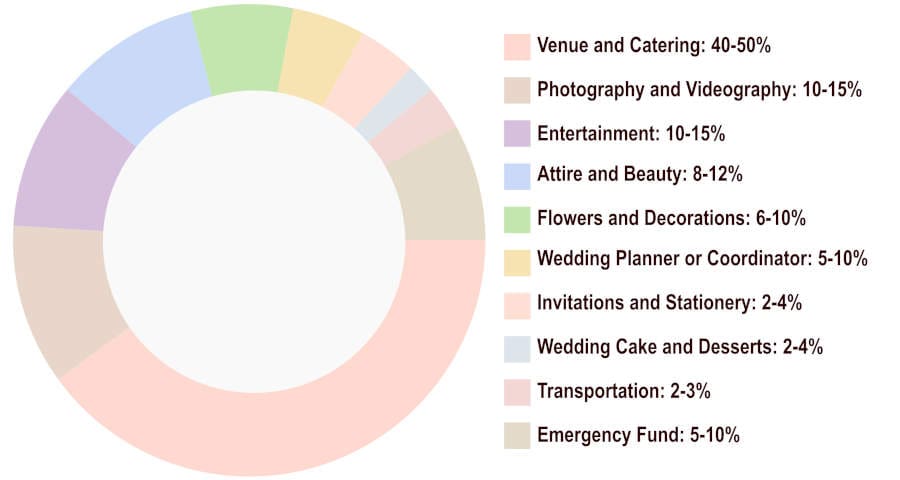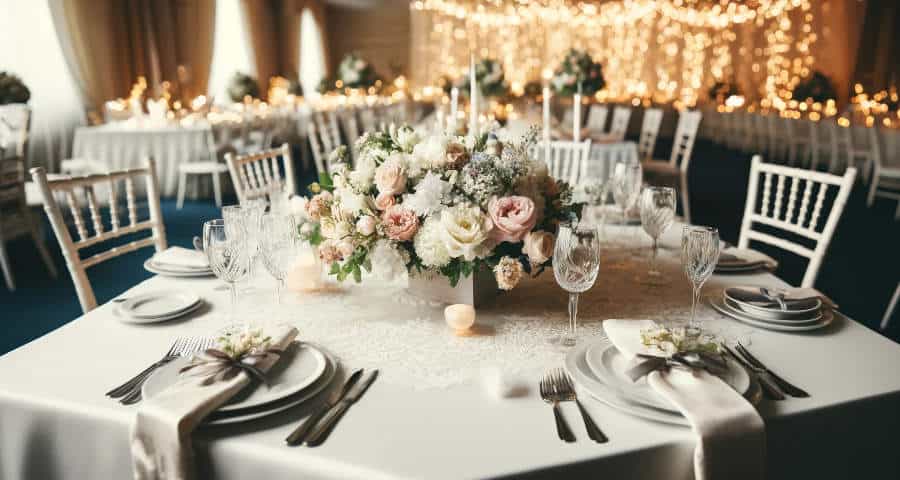Planning a wedding can be both exciting and overwhelming, especially when it comes to managing finances
Understanding the average costs of different aspects of a wedding is crucial for creating a realistic budget.
This knowledge enables you to allocate funds appropriately across various categories, ensuring that essential elements are adequately funded while preventing overspending in any one area.
You also need to know how much you plan to spend in total on your wedding. To help work this out, I wrote Setting Your Wedding Budget, which covers the steps and considerations you need to think about.
Typical Wedding Cost Breakdown

Here’s a typical breakdown of a wedding budget:
| Category | Percentage (%) |
|---|---|
| Venue and Catering | 40-50% |
| Photography and Videography | 10-15% |
| Entertainment | 10-15% |
| Attire and Beauty | 8-12% |
| Flowers and Decorations | 6-10% |
| Wedding Planner or Coordinator | 5-10% |
| Invitations and Stationery | 2-4% |
| Wedding Cake and Desserts | 2-4% |
| Transportation | 2-3% |
| Emergency Fund | 5-10% |
Note: These percentages are approximate and should be adjusted based on your personal preferences and priorities. Remember to account for other expenses, such as wedding favours, gifts for the bridal party, marriage licence fees, and gratuities when creating your budget.
Understanding the Main Wedding Costs

Knowing the main costs will help you create a more accurate and realistic budget.
With a clear idea of where the bulk of your money will likely go, you can allocate funds appropriately, ensuring all critical aspects of the wedding are covered without unexpected financial strains.
This foresight not only aids in managing your budget but also reduces planning stress, allowing you to focus on enjoying your special day.
To better understand how these costs are traditionally split among those involved,read my article on Who Actually Pays for the Wedding.
Venue and Catering (40-50%)
What It Includes: This category covers the cost of renting your wedding venue as well as the food and beverages served to guests. This can include:
- Venue rental fees for ceremony and reception sites
- Catering services for meals and drinks, including appetisers, main courses, desserts, and possibly alcohol
- Costs for tables, chairs, linens, and other essentials provided by the venue
- Service staff like waiters, bartenders, and kitchen staff
Photography and Videography (10-15%)
What It Includes: This covers professional photographers and videographers who document your wedding day from start to finish. Expenses include:
- Engagement shoot (sometimes included)
- Full-day coverage of the wedding by one or more photographers/videographers
- Post-production costs (editing, creating albums, digital files)
Entertainment (10-15%)
What It Includes: This category encompasses all forms of music and entertainment provided during the wedding, such as:
- DJ or live band for the reception
- Ceremony musicians (e.g., string quartet, solo pianist)
- Any special performances (e.g., dancers, magicians)
Attire and Beauty (8-12%)
What It Includes: This includes all clothing and beauty services for the wedding day:
- Wedding dress, veil, and alterations
- Groom’s suit/tuxedo and alterations
- Hair and makeup services for the bride and possibly bridal party
- Accessories like shoes, jewellery, and ties
Flowers and Decorations (6-10%)
What It Includes: All floral arrangements and decor items to enhance the aesthetic of your wedding:
- Bridal bouquet, bridesmaids’ bouquets, boutonnieres, corsages
- Floral arrangements for ceremony and reception
- Non-floral decorations such as lighting, drapery, and themed props
Wedding Planner or Coordinator (5-10%)
What It Includes: Services provided by a wedding planner or day-of coordinator to help organise and manage the wedding:
- Full planning services from start to finish or specific partial planning
- Day-of coordination services
- Assistance with vendor contracts, timeline, and logistics
Invitations and Stationery (2-4%)
What It Includes: All printed materials needed for the wedding:
- Save-the-date cards
- Wedding invitations
- RSVP cards
- Ceremony programs
- Menu cards
- Thank-you cards
Wedding Cake and Desserts (2-4%)
What It Includes: The cost of the wedding cake and any additional desserts offered at the reception:
- Wedding cake or multiple cakes
- Dessert bar or individual desserts like pastries, cookies, or a candy buffet
- Cake cutting and serving fees
Transportation (2-3%)
What It Includes: Transportation for the wedding day, including:
- Limousines, classic cars, or other rental vehicles for the bride, groom, and bridal party
- Shuttles or buses to transport guests, if needed
Emergency Fund (5-10%)
What It Includes: A contingency fund to cover unexpected expenses or last-minute adjustments, such as:
- Unforeseen vendor or venue costs
- Additional decor or rental needs
- Weather-related accommodations
Establish Your Priorities

Setting priorities for your wedding budget is crucial. It ensures your day reflects your dreams. This approach optimises expenditures. It also boosts the emotional and aesthetic success of your event.
Weddings involve numerous expenses. Knowing what matters helps you manage funds effectively. For example, if a dreamy venue is essential, allocate more budget there. Save on less important aspects like extravagant favours.
Without clear priorities, it’s easy to overspend in one area. This can leave you short in more crucial areas. Start with clear priorities. This way, your funds enhance your wedding day.
Understanding your priorities aids decision-making. It clarifies where cutting corners is okay and where it’s not. If some elements are essential, this knowledge helps you make compromises without regret.
Your wedding should reflect your personal style and relationship. Prioritising allows you to focus your budget on what truly shows off your personality. This could be through customised decor, unique entertainment, or gourmet food. Such focus makes your event more memorable.
Planning a wedding can be overwhelming. The decisions can be stressful. A clear set of priorities reduces this stress. It simplifies the planning process.
For couples, discussing and setting priorities is vital. It ensures both partners are aligned. Each person’s must-haves are respected. This approach prevents conflicts during planning.
Focusing your budget on what’s most important ensures satisfaction. You’ll know you invested in what truly mattered to you. Avoid spending on elements that didn’t add value.
Setting Your Budget

Creating a wedding budget begins with a clear understanding of your total available financial resources. This total includes your savings, contributions from family, and any other funds you plan to use for your wedding.
Start by confirming the amount you are willing to spend on your wedding. Knowing this total is crucial as it helps ensure you don’t inadvertently overspend, keeping your financial goals on track.
With your total budget in mind, initiate the allocation process. Distribute your funds across different categories, such as venue, catering, attire, and photography. Base these allocations on the typical breakdown of a wedding budget, but adjust them according to your personal priorities.
For example, if securing a spectacular venue is a top priority for you and your partner, you might allocate a larger portion of your budget to it while economising on other areas that are lower on your priority list.
Staying Flexible

Setting a budget is just the beginning, the real challenge and opportunity lies in staying flexible and adjusting your budget as plans evolve.
Your initial wedding budget serves merely as a starting point. As you progress with your planning, it’s crucial to track and update your expenses regularly.
Recording actual expenditures as they occur, including deposits, final payments, and unforeseen costs, helps you understand where your money is going and when adjustments are necessary.
Consider scheduling a monthly review of your budget. This routine check-in allows you to catch any over-expenditures early and provides a regular opportunity to assess your spending and make necessary adjustments.
If you find yourself over budget in a category, take the time to understand why.
Was it an initial underestimation, or did you choose a more expensive option than planned? Identifying the cause of overages can help you make more informed decisions going forward and prevent similar issues in other areas.
If you’re under budget in some categories, consider whether you can reallocate those funds to cover shortfalls elsewhere.
This might mean cutting back on less critical areas to enhance aspects of the wedding that are more important to you.
For example, savings on invitations could be redirected to upgrade your photography package or add a special touch to your décor.
Don’t hesitate to revisit discussions with your vendors if you need to adjust costs. Sometimes, negotiating pricing or exploring alternative options can help bring expenses down without compromising the quality of your wedding.
If you constantly find yourself under budget, consider placing the surplus into a contingency fund. This reserve can cover last-minute expenses that might arise unexpectedly. It’s a practical way to ensure you’re prepared for any situation.
Regular discussions about the budget with your partner are essential. These conversations ensure that both of you are aligned on financial decisions, including where to make cuts or enhancements.
Being transparent about costs and concerns can prevent misunderstandings and ensure that both partners are comfortable with the financial aspects of the wedding planning.
Be open to making alternative choices if certain desired items or services are too expensive. Look for creative, cost-effective solutions that align with your wedding vision. Sometimes, a less expensive option can turn out to be unexpectedly delightful.
For certain wedding elements, consider DIY options. Not only can this approach save money, but it also adds a personal touch to your celebration. Whether it’s crafting your own centrepieces or designing digital invitations, DIY projects can reduce costs while making your wedding uniquely yours.
Emergency Fund

Planning a wedding comes with its share of surprises and last-minute adjustments.
While we all hope for a seamless celebration, the reality is that unexpected expenses are almost a given in any large event, especially weddings.
An emergency fund acts as a financial cushion, absorbing the shock of unforeseen expenses without derailing your plans or budget.
This could range from last-minute vendor changes due to unforeseen circumstances, to sudden requirements for additional decor if your initial setup doesn’t meet your expectations or needs adjustments due to weather conditions.
One of the primary benefits of having an emergency fund is the peace of mind it offers.
Knowing you have a financial backup can significantly reduce stress. Wedding planning is overwhelming enough, and the last thing any couple needs is financial worries adding to their stress.
An emergency fund ensures that you’re prepared for any unexpected costs, allowing you to focus on enjoying your big day.
Without an emergency fund, unexpected expenses might force you to make unwanted compromises, such as choosing less desirable options or cutting desired aspects of your wedding altogether.
With an emergency fund, however, you maintain the integrity of your original wedding plan. It allows you to handle surprises without sacrificing the elements that are important to you.
Determining the amount to set aside in an emergency fund can vary, but a good rule of thumb is to allocate 5-10% of your total wedding budget to this fund. This percentage can be adjusted based on your overall budget size and the complexity of your wedding plans.
It should ideally be reserved for genuine emergencies that cannot be covered by rearranging other budget items. Examples include unexpected venue changes, last-minute equipment needs, or additional transportation for guests if there are logistical challenges.
If you find that you didn’t use all of your emergency fund, you have a pleasant decision to make. You can put it towards your honeymoon, save it for future plans, or even invest it back into thank-you gifts for your guests or post-wedding gatherings.
An emergency fund can be the difference between a minor hiccup and a major issue on your wedding day.
By setting aside a designated amount for unforeseen expenses, you ensure that any last-minute obstacles can be managed quickly and effectively, safeguarding your wedding experience and your peace of mind.
Remember, the goal of the emergency fund isn’t just to spend it; it’s to have it just in case, ensuring that your special day goes as smoothly as possible.

